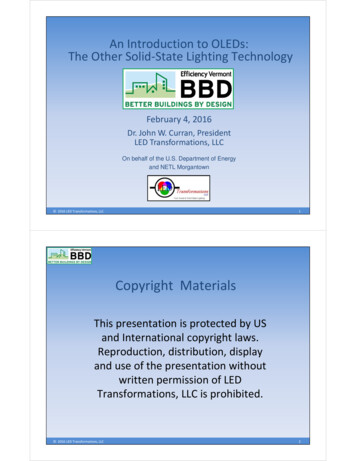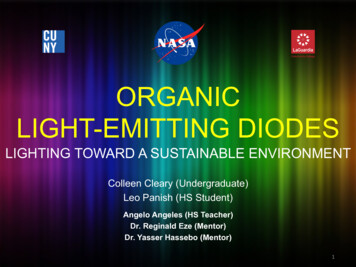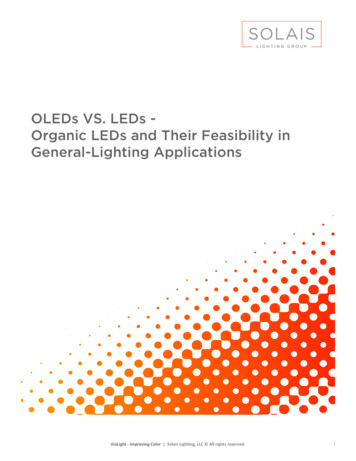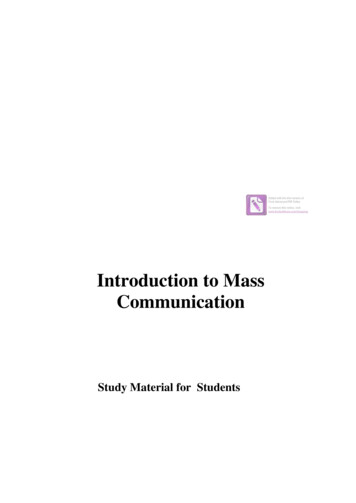
Transcription
An Introduction to OLEDs:The Other Solid‐State Lighting TechnologyFebruary 4, 2016Dr. John W. Curran, PresidentLED Transformations, LLCOn behalf of the U.S.U S Department of Energyand NETL Morgantown 2016 LED Transformations, LLC1Copyright MaterialsThis presentation is protected by USand International copyright laws.Reproduction, distribution, displayand use of the presentation withoutwritten permission of LEDTransformations, LLC is prohibited. 2016 LED Transformations, LLC2
Course DescriptionLEDs are the main topic of conversation when it comes tolighting. However, there is another solid‐state lighting familymember that is starting to attract attention. Organic light‐emitting diodes, or OLEDs, are beginning to move from beinghigh‐pricedg pnoveltyy pproducts to beingg more mainstreamillumination solutions. OLEDs offer new and exciting capabilitieswherein the light becomes the luminaire. In this presentation,Jack Curran will provide an introduction for those unfamiliar withthe technology. Included will be a comparison of OLEDs withLEDs, highlighting the advantages and disadvantages that OLEDsoffer, as well as what the future holds for this unique technology. 2016 LED Transformations, LLC3Learning Objectives1. Attendees will learn how OLEDs function and thefundamental differences between OLED and LED technology2. Performance comparisons between LEDs and OLED will bepresented allowing attendees to plan where OLEDs could bean appropriate choice for future facilities projects3. The physical characteristics of OLEDs will be discussed,providing attendees a basis for the aesthetic appeal of thetechnology to many lighting designers and architects4. Understanding how OLED’s unique properties can change thedesign of facilities in terms of lighting 2016 LED Transformations, LLC4
Outline Introduction – What are OLEDs Unique Features – What makes OLEDsdifferent from other light sources? Comparison – Advantages and disadvantagesof OLED and LED technologiesSource: GE AApplicationsli i– ExamplesEl off OLEDdesign 2016 LED Transformations, LLC5IntroductionCreating White Light With LEDs – PhosphorPh h approachhDownconverting Phosphor BlueBl LED YAG (Yttrium(Ytt ialuminuml igarnet)t) CoolC l WhiteWhit Blue LED YAG Other phosphor (red, green, etc.) Warm White UV LED Red phosphor Green phosphor Blue phosphorYellow and RedPhosphorCConventionti CoatingC tiYellow PhosphorCool/Warm White LED SpectraPhosphorConformal CoatingInGaN Die400450500550600Wavelength650700750Blue Die 2016 LED Transformations, LLC6
IntroductionHow does the LED make light?photonRadiative recombination– Photon generationelectronhole 2016 LED Transformations, LLC7IntroductionHow does the LED make light?Nonradiative recombination– Phonon or heat generationphotonelectronholeC t heatCreatesh t insteadi t d off lightli ht 2016 LED Transformations, LLC8
IntroductionCreating Light with LEDs – DifferentDifft colors;ldifferentdifft bandgapsb dProtonEc ‐ Bottom of Conduction BandNeutronElectronlEgInGaNEgAlInGaPEv ‐ TopT off ValenceV lBBanddElectronHolePhotonWhen electrons and holes combine, the resulting photon has a wavelength related to thebandgap energy given by λ 1239 / EgSmaller bandgap LowerLo er energenergy Longer wavelengtha elength photon RedLarger bandgap Higher energy Shorter wavelength photon Blue 2016 LED Transformations, LLC9IntroductionWhat is an OLED?A "layer cake" with a thickness less than that of a human hair An OLED or organicglight‐emittingggdiode is a semiconductor device whichconsists of an electroluminescentorganic layer(s) sandwiched betweentwo electrodeselectrodes, at least one of whichis transparent. The device is fabricated byqy depositingpg organicglayersysequentiallyon a conducting substrate followed byanother conducting electrode. A common device structurecomprisesia glassl substrateb t t coatedt dwith indium tin oxide (ITO) astransparent anode and a thin, opaquemetal film as cathode. Typical separation between layers is100 nm or less 2016 LED Transformations, LLC10
IntroductionWhat is an OLED?The major elements of an OLED device consist of the following: Substrate – the support material that forms the base of theOLED; it can be of glass, metal or plastic; Backplane – the circuitry that provides the power that drivesthe OLED panel (simple for lighting, complex for displays); Organicglayersy – the actual OLED materials; pphosphorescentpand fluorescent materials that convert electrical energy intovisible light energy; EncapsulationEncaps lation – the protectiveprotecti e layersla ers that preventpre ent moisturemoist reand oxygen from contaminating the organic (light producing)layers of the OLED. 2016 LED Transformations, LLC11IntroductionA CloseClose‐upup View of an OLEDDiagram of a Bottom Emitting, Stacked OLEDElectron Transport LayerH l BlockingHoleBl ki LayerLEmission Layers{Electron Blocking LayerHole Transport LayerITO ‐ Indium Tin Oxide layerfformsa transparent electrodeld 2016 LED Transformations, LLC12
IntroductionOLED Configurations – DifferentDifft structurest tffor diffdifferentt applicationsli tiOLEDs can be configured as larger‐area, more diffuse light sources, which may bepractical for generalgambient lightinggg because the soft lightg can be viewedmore pdirectly, with less need for shades, diffusers, lenses, louvers, or parabolic shells. Thediffuse light from OLEDs allows them to be used very close to the task surfacewithout creating glare for the user, which means that less total light can be used inorder to achieve desired illuminance levelslevels.Source: OLED Basics; US Department of Energy 2016 LED Transformations, LLC13IntroductionOLED Materials – PhosphorescentPh ht versus flfluorescenttOLED emissive layer can be made of either phosphorescent orfluorescent materials Phosphorescent Materials (PHOLED)– More efficient with upp to 100% internal quantumqefficiencyy ((IQE))– Lifetimes are typically shorter, particularly blue– Require heavy metals, typically iridium which is also in short supply Fluorescent Materials– Longer lifetimes than phosphorescent– Less efficient with the maximum internal quantum efficiency of only 25% Hybrid approach– Use phosphorescent for red and green layer– Use florescent for blue layer 2016 LED Transformations, LLC14
IntroductionThe LED Marketplace – LEDsLED taket k overLuminaire Unit Shipments byLamp Type, World MarketsSource: Navigant % 2016 LED Transformations, LLC15IntroductionThe OLED Market – ExpandedEd d growthth as costst come ddownSource: Yole DevelopmentSouce: Yole Development 2016 LED Transformations, LLC16
IntroductionOLED Market Forecasts – WidelyWid l varyingi projectionsj ti Lux Research – 58M by 2020 NanoMarkets – 1.4B by 2019 UBI Researchh – 4.7B bby 2020OLED Lighting MarketSales in M US)5,0004,0003,0002,0001,00002015Source: UBI Research20162017201820192020Year 2016 LED Transformations, LLC17IntroductionAn Experiment – WhatWh t colorl iis ththe bball?ll? 2016 LED Transformations, LLC18
IntroductionAn Experiment – WhatWh t colorl iis ththe bball?ll?Without light objects have NO ColorRed object – Absorbs blue & green 2016 LED Transformations, LLC19IntroductionCreating White Light With LEDs – RGB approachhCombining different LED colors provides awide spectrum of possibilities – including white 2016 LED Transformations, LLC20
Outline Introduction – What are OLEDs Unique Features – What makes OLEDsdifferent from other light sources? Comparison – Advantages and disadvantagesof OLED and LED technologiesSource: GE AApplicationsli i– ExamplesEl off OLEDdesign 2016 LED Transformations, LLC21Unique FeaturesSome OLED Terms Small molecule OLEDs (SM‐OLEDs)– Molecule weight less than 11,000000 g/mole– Majority of today’s devices, high performance, generally deposited byvapor phase deposition LargeLmoleculel l OLEDsOLED (P‐OLEDs(P OLED or PolymerP lOLEDs)OLED )– Are solution processable (i.e. ink‐jet printing and spin coatingfabrication which could drastically reduce manufacturing cost)– Still at the development stage Phosphor – a material that emits light at low temperatures– Florescent – decay time for light emission occurs within a fewnanoseconds (10‐9 seconds)– Phosphorescent – decay time for light emission occurs within a fewmilliseconds (10‐3 seconds) 2016 LED Transformations, LLC22
Unique FeaturesSome OLED Terms Stacked OLED– Simple stack – organic material sandwiched between the twoelectrodes For RGB organic layers, can only produce white light– True stack – each of the three organic layers is separated by anelectrode to allow each layer to be controlled independently Device can create a range of colors WhiteWhit OLED fabricationf b i ti– Combine red, green and blue OLEDs– Combine blue and yellow OLEDs (similar approach to white LEDs) Emission direction (pertains mainly to display devices)– Bottom emitting: reflective cathode / transparent anode (ITO)– Top emitting: reflective anode (ITO) / transparent cathode 2016 LED Transformations, LLC23Unique FeaturesResearch – DrivenDibyb displaydi l needsd presentlytlMajorityj y of commercial investment in OLED technologygy has beenfocused on display applications – for example,Samsung has recently averagedabout 5B per year.yearSource: LG ElectronicsLG plans to produce 600,000600 000 OLEDTVs (55", 65" and 77" during 2015 2016 LED Transformations, LLC24
Unique FeaturesSome OLED Terms – WhatWh t ddoes ""gen"" mean“Gen” refers to the ggeneration of manufacturingg line which isbased on size of glass panel which the line is capable ofproducing. Each generation is capable of producing largerand larger panels of glass.glass This brings down the cost of thesubstrate on which the OLED is manufactured.PresentlyGen 5.5Source: CLSA Asia‐Pacific Markets 2016 LED Transformations, LLC25Unique FeaturesHistory of OLED Development – DisplaysDi landd some lilightinghti 1950: Electroluminance in organic materials is observed for the first time1987: The world’s first OLED device is developed at Eastman Kodak First visible LED1998: Kodak and Sanyo show the world’s first AMOLED displaydeveloped 22years earlier2009: LG buys Kodak OLED unit2010: Sony stops XEL‐1 OLED TV production2010: DuPont develops new OLED printing technology, can print a 50″ panel in lessthan two minutes2011: Samsung announces they will invest 4.8 billion in OLED production in 20112011: Verbatim starts shipping color‐tunable OLED lighting panels (VELVE)2011: Panasonic develops the world’s most efficient white OLED (128 lm/W)2012: The world’s first transparent OLED lighting panel now shipping fromCOMEDD2013: NEC developed the world’s most efficient OLED lighting device (156 lm/W)2014 LG shows2014:h77” bendableb d bl OLED TV prototypesSource: The OLED Handbook; Ron Mertins; 2014 2016 LED Transformations, LLC26
Unique FeaturesAdvantages of OLEDs Flat Form Factor– Emits light over entire surface; also allows for easy heat dissipation FlexibilitySource: DuPont Displays– As encapsulation techniques improve, ability to useflexible substrates such as metal foils or plastic Color Tunability– Spectra depends on the emitter material; generallywider and more flat than that of inorganic LEDs Efficiency– Target for 2020 is 190 lumens/W– Very low luminaire efficiency lossesSource:Novaled Transparency– Transparent OLEDs can be made which emit lightfrom both sides when on, and are see‐through in theiroff state (using transparent electrodes & substrate materials) 2016 LED Transformations, LLC27Unique FeaturesHow LEDs Achieve Diffuse Light – EdgeEd lightingli htiSource: Shenzhen Powerstar 2016 LED Transformations, LLC28
Unique FeaturesFlexibilitySource: Michael Hack, Universal Display Corporation 2016 LED Transformations, LLC29Unique FeaturesTransparency – DisappearsDiwhenh nott ini useSource: Universal Display CorporationSource: Yuan‐Sheng Tyan, Kodak 2016 LED Transformations, LLC30
Unique FeaturesColor Tunability – BroadB d spectrat Wide range of phosphors andfluorescent materials allowsbroader spectra thanavailable with LED technology LLayer geometryt allowslluniform mixing of colorswithout ppixialization or colorshadows that often occurwhen mixing LED colors 2016 LED Transformations, LLC31Unique FeaturesColor Tunability – BroadB d spectratA combination offlexibility and colortunabilitybiliSource: Konica‐Minolta 2016 LED Transformations, LLC32
Unique FeaturesThe Major Issues – Performance,P fcostt andd liflifetimeti Trapping of light inside OLED layers Phosphorescent blue material does not match performanceof red and green– Use of hybrid fluorescent blue and phosphorescent red and green Unlikely development of low cost, lowresistance, transparent sheet conductorsOLED defects causedby moisture1– Use of wire grids may eliminate this issue Encapsulation to avoid moisture contamination Low volume production means high cost– Cost reductions driven by display manufacturing which typically doesnot require the high light output, long lifetimes and high efficacyreq ired for lightingrequiredSource: Yuan‐Sheng Tyan, Kodak– Initial luminaire may require tiling approach1 2016 LED Transformations, LLC33Unique FeaturesThe Major Issues – Performance,P fcostt andd ome lab devices can competewith conventional technologies,early products have low efficacyWork needed to develop efficient,long‐lasting blue emitter; nextgeneration products reaching levelsthat compete with conventionallighting sourcesWork needed on high current density,Short lifetimes for blue materials;more stable materials, better and lowsusceptibility to moisture intrusioncost encapsulationLightOutputCurrent OLED packages produce“dim” lightWork needed to improve lightextraction, high current densityCostToo high; lower cost device andluminaire materials are neededInfrastructure investment needed todevelop commercial OLED productsTestingStandards 2016 LED Transformations, LLCNeed for reliable test methodsNo standardsd d presentlyl availablel blstandards to establish consistency andfor testing OLED productsreduce uncertainty34
Outline Introduction – What are OLEDs Unique Features – What makes OLEDsdifferent from other light sources? Comparison – Advantages and disadvantagesof OLED and LED technologiesSource: GE AApplicationsli i– ExamplesEl off OLEDdesign 2016 LED Transformations, LLC35ComparisonLifetime Considerations – TraditionalT ditil vs. LED llamps Traditional lampsX XX X XChoose a statistically valid population of lampsXXRun them at specified ambient temperatureXX XXCycle them on/off at a prescribed patternXX XThe time at which half the population has failed X Xis considered the lifetime for that lamp– Typically this process can take up to 15 months for lamps rated at10 000 hours10,000–––– LED lamps– Since LEDs typically don’t fail catastrophically, but rather slowly dim,theh iindustrydhhas ddefinedfi d endd off liflife to bbe theh pointi at whichhi h theh LLEDoutputs 70% of the light it produced initially– Need a different method of measuring lifetime– More on thath subjectbin Section 4 2016 LED Transformations, LLC36
ComparisonLED Luminaire Lifetime – A lluminairei i isi a systemtThe failure of anyy onecomponent can causethe entire system tostop functioningLED sourceLuminaire designers maketrade‐offstradeoffs among thecomponents, depending onthe desired performancecriteriait i – forf examplel thethnumber of LEDs ( ) versusdrive current uminaireHousing 2016 LED Transformations, LLC37ComparisonElectronics/Driver – ReliabilityR li bilit dependsdd on theth driverdias wellllTwo examples of failures caused by the driverStop & Shop, Raritan, NJ – 6 weeksCity Center, Las Vegas – 5 monthsNot quite 50,000 hours! 2016 LED Transformations, LLC38
ComparisonElectronics/Driver – ReliabilityR li bilit dependsdd on theth driverdias wellllSource Appalachian Lighting SystemsSource: 2016 LED Transformations, LLC39ComparisonOLED Lifetimes – DependsDd on theth colorl ((phosphor)h h )OLED lifetimes canvary byb two ordersdof magnitude(100x's) based onthe phosphor usedSource: UniversalDisplay CorporationPHOLED ColorDeep RedRedRedYellowGreenLight BlueCIE 1931 ColorCoordinatesLifetime ‐ 95%((in hours))Lifetime ‐ 50%((in hours))0.69, 0.310.66, 0.340.64, 0.360.44, 0.540.31, 0.630.18, 0900,0001,450,000400,00020,000LED lifetimes as a function of color show much less variationSource: Lighting Research Center 2016 LED Transformations, LLCRoyal BlueBlueGreenAmberRedL70 in hours1 86,90079,60059,900127,00098,600Source: Cree40
ComparisonOLED Different Shapes & Sizes – UpU tot 320 mm2 ini a singlei l panellLG ChemLumiotecPhilips – LumibladeOsram 2016 LED Transformations, LLC41ComparisonEfficacy – WhatWh t it iis andd whyh it iis iimportantt tEfficacy is a measure of the performance of a device. For lightingefficacy is measured in lumens per watt.watt The higher the efficacy,efficacythe greater the energy savings.Typical Light Source EfficaciesAt least oneLED mfg nowoffers an LEDwith efficacyof 200 lm/W(at 25OC and350 mA)Source: DOE publication Energy Efficacy of LEDs (March 2013) 2016 LED Transformations, LLC42
ComparisonLED Luminaire Efficacy – Wherehtheh llosses come ffromOutputp of the LEDs is onlyy the startingg ppointLED efficacy (@ 25OC & 350 mA)Temperature Loss (@85OC)Drive Current Loss (1050 mA)Driver LossSecondary Optics LossFixture Loss87.9%87 6%87.6%87.5%90%95% 200 lumens/watt 175.8 lumens/watt 154.0154 0 lumens/watt 138.6 lumens/watt 127.5 lumens/watt 121.1 lumens/watt/ LEDs yieldsya luminaire efficacyy of about 121 lm/W/A fixture usingg 200 lm/WOLED fixture designs typically don't have these losses 2016 LED Transformations, LLC43ComparisonGlare Reduction – OLEDsOLED offerff a ""softer"ft " lilightht outputt tThe LED's point‐source characteristic concentrates the light attheh source whichh h creates an intense bbeam whichh h can cause glarelwhen viewed directly.The OLED's uniform light distribution spreads the light over theentire area of the panel creating a soft, glowing light sourcewhenh viewedid directly.di tl 2016 LED Transformations, LLC44
ComparisonSpectral Power Comparison – LessLsevere didip iin theth greenOLED spectralppowerpdistribution can be designedgto more closelyymatch natural sunlight that the corresponding LED spectrumSource: LG ChemLED Green Gap 2016 LED Transformations, LLC45ComparisonCreating White Light With OLEDs – Phosphorh h approachhColor shadows result from insufficientmixing of the RGB LED sources. Slightphysical separation of the differentLED RGB sources causes distinctshadows from each source.Designers typically solve this by usingeither secondary optics or mixingchambersSource: Scott W. Vincent / http://www.lungstruck.com/tag/led/The narrow separation betweenRGB elements of the OLEDlayout minimizes any shadowingSource: DuPont 2016 LED Transformations, LLC46
ComparisonLEDs and Drivers – SomeSbasicsb iWhy do we need drivers (power supplies)? LEDs are non‐linear devices (If vs. Vf) with aforward voltage that is temperaturedependent – they operate best whenprovided with a constant current source LEDs are low voltage devices (with typicalforward voltages ranging from 2.8 – 3.5 V).Th requireTheyi some minimumi iconditioningdi i i LEDs are diodes and therefore will onlySource: Philips Lumileds data sheetoperate when current flows in one direction Theh llighth source thath LEDs replacelwithh theh greatest improvement inefficacy (incandescent) are purely resistive loads with a Power Factorequal to 1 – therefore it is desirable for the driver circuitry to providea power factor as close as possible to 1 Drivers also need to control harmonic current effects on the mains 2016 LED Transformations, LLC47ComparisonSwitch Mode Power Supply – WhatWh t iis it?Advantages Greater efficiency since the switching transistordissipates little power when acting as a switch Smaller size Lighter weight from the elimination of heavyli fline‐frequencyttransformersf Lower heat generation due to higher efficiencyDisadvantages Greater complexity Generation of high‐amplitude,high‐frequencygqy energygy thatrequires a low‐pass filterto blockFirst Switched Mode Power Supply PatentSource: Philips Semiconductors –Power Semiconductors Applications 2016 LED Transformations, LLC48
ComparisonControlling LED Light Output – AmplitudeA lit d andd PWM modulationd l ti Amplitude modulation controls the amount of light output from the LEDsby varying the amount of current flowing through the LEDs PWM controls the amount of light output from the LEDs by turning themon and off very quickly (typically thousands of times per second). Thepercentage of time the LEDs are on is the duty cycle and is directly relatedto their light output (e.g. 50% duty cycle results in 50% light output ascompared to constant current)Pulse Width ModulationAt highg output,p , the switch is held on most of the pperiod;; for less output,p ,the percent of on time is reduced. Losses include switch and inductorresistance and heat generated in the flyback diode (still small)Amplitude ModulationAt max and min output, powerwasted in adjustable resistor is at aminimum while at 50% setting, halfoff theh power isi wastedd iin thathresistor. If load appears reactive, thisefficiency drops further95%50%5% 2016 LED Transformations, LLC49ComparisonDrivers – LED andd OLED devicesd irequirei diffdifferentt ddriversi LEDs– Can use constant voltage or constant current OLEDs– Requireqconstant current onlyy Static resistance of OLED devices increases over time. If used with a constantvoltage device, the drive current will decrease resulting in loss of light outputOLED driven with constant voltage sourceOLED driven with constant current sourceL70 pointNote decrease in lumen depreciation over time for constant current caseSource: Osram 2016 LED Transformations, LLC50
ComparisonDrivers – OLED ddevicesirequirei constantt t currentt ddriversiThe light output of an OLED device is also much more sensitive tochangeshini voltagelthanh currentSource: Osram 2016 LED Transformations, LLC51ComparisonDrivers – OLED characteristicsht i ti The preferred method to dim OLEDs is by changing the DCamplitudeli d off theh drived i current to avoidid shorteninghi OLED lifelif The use of Pulse Width Modulation (PWM) dimming drivers willsignificantly shorten the life of the OLED device Due to the high capacitance of OLEDs, the driver should bedesigned to take that into account. Otherwise high current orvoltagelspikesk may resultl on turn‐on/turn‐off/ff or at edgesdoffPWM signals Drivers for use with OLED devices should be designed to provideminimum ripple current, unlike LED drivers which often tradehigher ripple current for lower costSource: Osram 2016 LED Transformations, LLC52
ComparisonEfficacy – TargetsTt ffor OLED ddevicesiComparison of OLED and LED Target ProjectionsLED Package Efficacy Projections(Commercial Products)OLED Efficacy Projections(White Light Panels)Source: DOE Solid‐State Lighting R&D Plan, May 2015 2016 LED Transformations, LLC53ComparisonOLED Efficacy – WhereWhtheth losseslare 2016 LED Transformations, LLC54
ComparisonLED/OLED Comparison – WhereWhimprovementit willill come fromfLED ImprovementsOLED ImprovementsSource: DOE Solid‐State Lighting R&D Plan, May 2015 2016 LED Transformations, LLC55ComparisonOne Cost Advantage of OLEDs – OpticsO ti andd ththermallOLED savingsin these areasSource: Manufacturing Roadmap Solid‐State Lighting Research and Development ; US Department of Energy, August 2014 2016 LED Transformations, LLC56
ComparisonOLED Efficacy – DOE goalsl andd presentt performancefDOE ggoalsSource: US Department of EnergySSL R&D Plan, May 20151 Efficacyprojections assume CRI 80, CCT 3000KComparison of commercialversus lab performance1Commercialpanel utilizing a hybrid triple stack with fluorescent blue emitters and phosphorescent red and green.ppanelutilizingg a hybridy6‐stageg stack with fluorescent blue emitters and pphosphorescentpred and ggreen.3Laboratory panel utilizing a double stack with all phosphorescent emitters4Test panel utilizing a single stack with polymer/oligomer emitters2Commercial 2016 LED Transformations, LLC57ComparisonOLED Research Projects – ProgramsPfundedf d d byb theth DOEOLEDResearchProgramsSource: US Department of Energy R&D Roadmap, May 2014 2016 LED Transformations, LLC58
ComparisonDOE Research Grants – All aspectst off solid‐statelid t t lilightinghtiDOE SSL R&D Active PortfolioOLED ProductDevelopment7%LED ProductDevelopment15%Total 50.9MOLED Core Technology8%LED Manufacturing43%The DOE supports SSL R&Din partnership withindustry small business,industry,businessand academia. Presentlythere is 50.9 in funding forthe current solidsolid‐statestatelighting portfolio.Approximately 29% of thisfunding is focused on OLEDtechnology issuesLED Core Technology13%OLED Manufacturing14%March 2015 2016 LED Transformations, LLC59ComparisonComparing Approaches – VacuumVdepositionditi versus iinkk jjettTwo approaches to OLED manufacturingInk jet printingSource: CanonVacuum depositionSource: Aixtron 2016 LED Transformations, LLCSource: Kateeva60
ComparisonOLED Manufacturers – ManyMunfamiliarf ili names ffor lilightinghti Acuity BrandsAstron Fiamm (Blackbody)First O‐LiteKanekaKonica MinoltaLedon/TridonicLG ChemChLumiotecMoser Baer TechnologiesOLEDWorks Osram OptoPanasonicPhilips LightingSamsungSumitomo ChemicalToshibaV b tiVerbatimVisionoxWAC Lighting 2016 LED Transformations, LLC61ComparisonCost – PrintableP i t bl OLED LiLightinghti GE and DuPont announced a pilotprogram a fewf years ago to integrateGE’s pre‐pilot roll‐to‐roll manufacturinginfrastructure with:– High performance, solution processablematerials– Advanced device architectures– Advanced encapsulation using ultra‐highmultilayer barrier films (alternateceramic/plastic layers) GGoal:l EliminateEli idifferencesdiffini OLEDperformance between laboratory‐scalebatch process and pre‐pilot production Not much progress in the last few years 2016 LED Transformations, LLCGE roll-to-roll OLED linedemonstration, 200762
ComparisonCost – PrintableP i t bl OLED LightingLi htiNot all programs are successful Project announced for upstate NY– Project partners: DOE, UniversalDisplay Corporation, Moser BaerTechnologies NY’sTechnologies,NY s Smart SystemTechnology & CommercializationCenter (STC)Located in Canandaigua, NY, the STC will house twopilot phosphorescent OLED manufacturing lineslines. Joint effort to design and set upnation’s first pilot production facilityfor OLED lighting panels FacilityF ili was to provideid prototype panelsl to U.S.U S luminairel i imanufacturers to incorporate into products Funding fell through and the project did not progress 2016 LED Transformations, LLC63ComparisonCost – MoreMrecentt manufacturingf t i sitesitLG is planning to construct a new production line for OLEDli h i bylightingb 2017.2017 TheyTh willill commiti 185M towardd thishi newfabrication line, which will increase its production capacity andwill lower prices dramatically.LG also plans to build a new manufacturing plant in Paju Koreascheduled to go on line by 2018. They plan to invest 8.7B in thefacility which will include Gen 9 glass fabrication capability.capability whichshould reduce their cost of display panels by up to 90%Theyy also announced that theyy will build a new 6‐Gen ((1500x1850mm) flexible OLED fab at their Gumi production facility. The plantwill cost 900M and will have a monthly capacity of 7,500 (1.5million 5.55 5" panels) Production is scheduled to begin in the first halfof 2017. 2016 LED Transformations, LLC64
ComparisonCost – MoreMrecentt manufacturingf t i sitesitKonica Minolta in 2014 completeda 100M fabricationf b i i facilityf ili withihcapacity to produce 1,000,000flexible panels per month using aplastic substrate with a roll to rollprocessLargest OLED panels presently available are made by LG andmeasure 320mm x 320mm (12.6(12 6" x 12.612 6")) and cost over 600. 600Apple is rumored to be planning to convert to OLED displays intheir iPhone 8 scheduled for introduction in 2018 which coulddramatically increase the demand for OLED panels 2016 LED Transformations, LLC65ComparisonPatterns – SimpleSi l displaysdi lwithith hihighh resolutionl ti andd llow power ddrawUse of OLEDs with patterns High resolution (down to thethickness of a human hair) with finedetail Half‐tonesH lfdi l possibledisplayibl Only the illuminated areas consumepower, thus saving energy whenused as displays Image disappears when OLED isturned off 2016 LED Transformations, LLC66
ComparisonLight Extraction – LED approachhDue to the high Index of Refraction of the semiconductor( s) as compared(nd to theh epoxy ddome materiali l ((ne),)by Snell’s law, photons exiting the active layer atangles greater than the escape cone angle θcwillill beb reflectedfl t d backb k intoi t theth semiconductori d tActive layerand will not exit the device.neθcnsAbsorbing substrateSome device manufacturers cut the sides of the chips to provide better exitangles and extract more light while others rough the surfaces of the chipsto create optical interfaces which can improve the overalllight extraction. A third approach is to use what are knownas photonic crystals to reduce certain propagation modes(reflected) and increase others (exiting).Source: Lumileds 2016 LED Transformations, LLC67ComparisonLight Extraction – OLED approachhLight extraction is a problem with OLEDs as well as LEDs. Inthe case of OLEDs, the light gets trapped in the thin organiclayers due to the high difference i
1987: The world’s first OLED device is developed at Eastman Kodak 1998: Kodak and Sanyo show the world’s first AMOLED display 2009: LG buys Kodak OLED unit First visible LED developed 22










